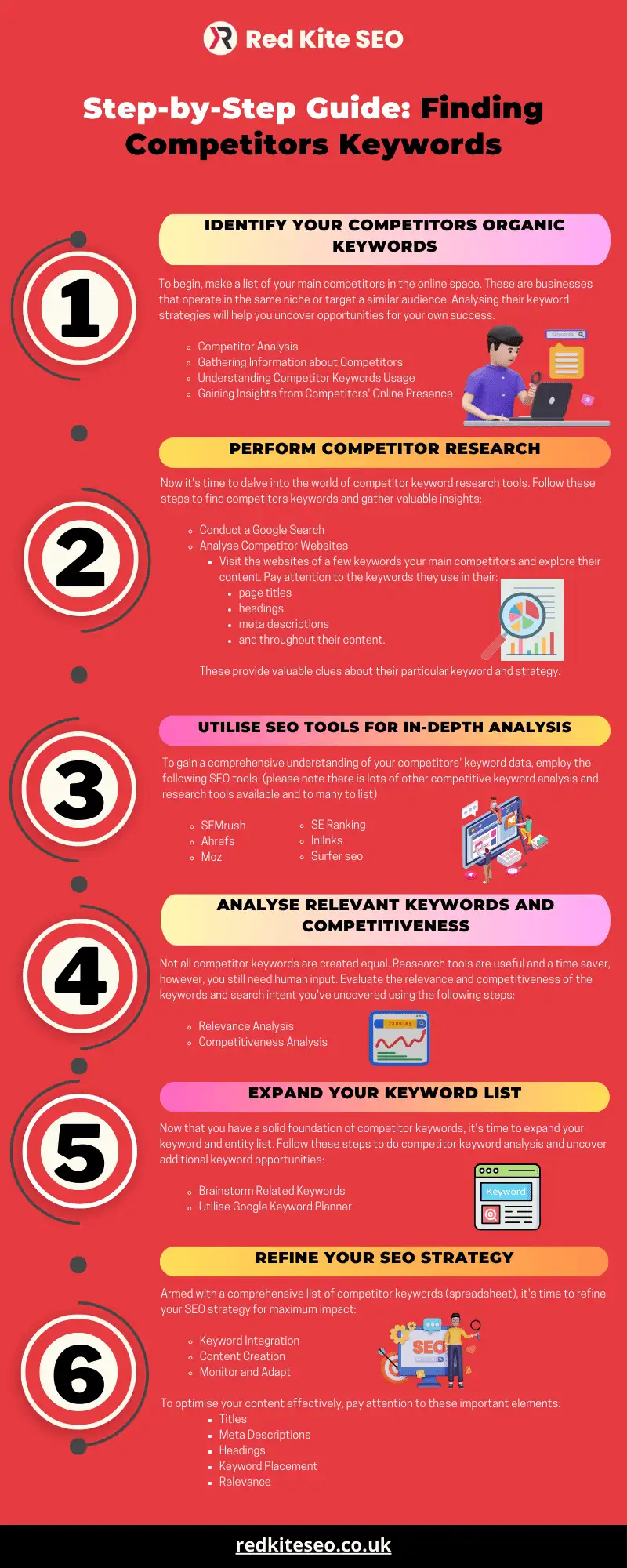Step-by-Step Guide: How to Finding Competitors Keywords and Outshine the Competition
In the ever-evolving digital landscape, finding the right keywords can make all the difference in boosting your online visibility and outshining your competitors.
Understanding the keywords your competitors are targeting provides valuable insights that can inform your SEO strategy and drive success.
In this step-by-step guide, we’ll walk you through the process of using organic keywords and finding competitor keywords, utilising the latest research techniques and powerful tools.

Important note to remember, search terms and entity’s in your industry and website need to be covered, and included in your content. More about that in another post, for now, let’s dive in!
Step 1: Identify Your Competitors Organic keywords
To begin, make a list of your main competitors in the online space. These are businesses that operate in the same niche or target a similar audience. Analysing their keyword strategies will help you uncover opportunities for your own success.
Competitor Analysis

Competitor keyword profile analysis plays a crucial role in identifying competitors’ keywords and gaining a competitive edge in the online world. By using keyword competitive analysis and examining the strategies, website content, and keyword usage of your competitors, you can uncover valuable insights to enhance your own keyword research and optimisation efforts.
Gathering Information about Competitors
One of the key aspects of competitor analysis is gathering information about your competitors. This involves analysing their websites, social media profiles, online ads, and any other relevant sources to understand their strategies and tactics.
By exploring their website content, you can identify the keywords they are targeting and gain insights into their overall keyword strategy.
Understanding Competitor Keywords Usage
Competitor analysis allows you to uncover the keywords your competitors are using to drive organic search traffic.
By examining their website content, meta tags, headings, and other on-page elements, you can identify how competitors rank the keywords they are optimising for organic search campaigns. This information can help you discover new keyword opportunities or improve your existing keyword targeting.
Gaining Insights from Competitors’ Online Presence
Studying your competitors’ online presence provides valuable insights that can inform your own keyword research and optimisation strategies.
By examining their website design, user experience, and content structure, you can identify areas where you can improve and differentiate yourself from your competitors.
Additionally, analysing their social media presence and online engagement can help you identify popular topics and trends that you can leverage in your content marketing efforts.
Step 2: Perform Competitor Research
Now it’s time to delve into the world of competitor keyword research tools. Follow these steps to find competitors keywords and gather valuable insights:
2.1. Conduct a Google Search:
Enter relevant search terms related to your industry or niche. Note the top-performing websites that consistently rank high in organic search results. These are your direct competitors.
2.2. Analyse Competitor Websites:
Visit the websites of a few keywords your main competitors and explore their content. Pay attention to the keywords they use in their:
- page titles
- headings
- meta descriptions
- and throughout their content.
These provide valuable clues about their particular keyword and strategy.
Unlocking the Secrets of Organic Search Traffic

Do you want to know how your competitors are attracting tonnes of visitors to their websites? It’s time to dive into the world of organic search traffic analysis. By understanding the keywords that are driving the most traffic to their sites, you’ll uncover their secret strategies for ranking high on search engine result pages (SERPs).
The Magic of Organic Search Traffic Analysis
Get ready to unveil the competitor url keyword strategies that are making waves. By studying the keywords that are bringing in a flood of visitors to their websites, you’ll discover the exact words and phrases that their audience loves.
But that’s not all! Organic search traffic analysis also helps you find golden opportunities to shine. By spotting the same keywords your competitors are rocking, you can size up the competition and uncover untapped areas where you can steal the spotlight.
Unleash the Power of Organic Search Traffic Analysis
Now that you know the secrets, it’s time to put them into action. Organic search traffic analysis is your key to understanding your competitors’ keywords and keyword strategies and finding new opportunities to shine.
So, grab your tools and dive deep into the fascinating world of organic search traffic analysis. Your website’s success awaits!
Keep learning, keep growing, and watch your organic search traffic skyrocket!
Step 3: Utilise SEO Tools for In-Depth Analysis

To gain a comprehensive understanding of your competitors’ keyword strategies, employ the following SEO tools: (please note there is lots of other competitive keyword analysis and research tools available and to many to list)
3.1. SEMrush:
SEMrush is a powerful tool that allows you to analyse your competitors’ organic and paid search keywords. Enter the website URLs of your competitors to discover the keywords they rank for, their search volumes, and even the traffic generated from these keywords.
3.2. Ahrefs:
Ahrefs provides detailed insights into your competitors’ backlink profiles, organic search traffic, and keyword rankings. Use this free tool to identify the keywords your competitors are targeting and uncover gaps in your own strategy.
3.3. Moz:
Moz offers a range of SEO tools, including their Keyword Explorer. This tool allows you to enter your competitor’s domain to discover the keywords they rank for and obtain valuable metrics about organic competitors, such as keyword difficulty and search volume.
3.4. SE Ranking
SE Ranking has improved over the last ranking history the last 4 years and has a firm database of keywords to access. Their keyword research tools offer, related, suggested and long-tail search terms. Along with keyword difficulty and search volume.
3.5. InlInks
InLinks is a powerful SEO tool that helps website owners optimise their content for search engines. By analysing entities and their relationships within a webpage, InLinks offers valuable insights to improve on-page SEO and enhance organic visibility.
3.6. Surfer seo
Surfer SEO is a comprehensive keyword research tool that provides data-driven insights to optimise your content for search engines.
With advanced features like SERP analysis and content recommendations, Surfer SEO empowers website owners to create highly optimised, search engine-friendly content that ranks higher and attracts targeted organic traffic.
Keyword Research Tools of the Trade
Now that you’re equipped with the power of organic search traffic analysis, let’s explore some handy tools:
- Google Analytics: It’s like having a detective’s magnifying glass. Google Analytics reveals the keywords that are driving organic traffic to your competitors’ websites. Analysing this keyword data often unveils patterns and trends that will guide your own keyword strategy.
- SEMrush: This superhero tool lets you peek behind the scenes of your top competitors’ organic and search rankings and traffic. Discover the keywords they’re ranking for and gain insights into search volume, competition level, and keyword difficulty. It’s like having your very own spy gadgets!
- SimilarWeb: Unleash the magic of SimilarWeb to reveal your competitors’ traffic sources. Find your competitors keywords and find out which keywords are bringing them organic traffic and understand how successful they are in attracting visitors. It’s like having a secret map to success!
Step 4: Analyse Relevant Keywords and Competitiveness
Not all competitor keywords are created equal. Reasearch tools are useful and a time saver, however, you still need human input. Evaluate the relevance and competitiveness of the keywords and search intent you’ve uncovered using the following steps:
4.1. Relevance Analysis:
Assess whether the keywords align with your business, target audience, and content strategy. Focus on keywords that are highly relevant to your offerings and are likely to attract valuable visitors.
4.2. Competitiveness Analysis:
Consider the competitiveness of each target keyword. Highly competitive keywords may be challenging to rank for, especially if you’re just starting out. Balance your strategy by targeting a mix of high-competition and long-tail keywords to increase your chances of success.
Competitive Intelligence

Competitive intelligence is the process of gathering information and insights about:
- Competitors’ strategies
- market position
- keyword usage
- target audience.
It plays a crucial role in understanding the competitive landscape and identifying opportunities for growth.
By analysing competitors’ keywords, businesses can gain a deeper understanding of their customers’ search behaviours and preferences. This knowledge allows for more effective keyword targeting and increased visibility of paid keywords in search engine results.
There are several tools and techniques available for conduct competitor analysis and gathering competitive intelligence.
Conducting competitor audits is a common practise, where businesses analyse their rivals’ websites, content, and backlink profiles. This further competitive analysis helps identify keywords and strategies that are working well for the competition.
Social media monitoring tools are also valuable for gathering competitive intelligence. They provide insights into competitors’ social media activities, customer engagement, and online reputation.
By monitoring competitors’ social media presence, businesses can identify emerging trends and adapt their keyword targeting strategies accordingly.
In summary, competitive intelligence is vital for businesses to stay ahead in the digital marketing landscape.
It enables them to make more informed decisions about their keyword targeting, allowing for improved visibility, increased organic traffic, and ultimately, greater success in attracting and engaging their target audience.
How do you monitor a competitor’s social media presence?

Monitoring a competitor’s social media presence can provide valuable insights into their strategies, audience engagement, and overall performance. Here’s a step-by-step guide on how to effectively monitor your competitors on social media:
- Identify Your Competitors: Start by identifying the main competitors in your industry or niche who have a significant presence on social media platforms.
- Select Social Media Platforms: Determine which social media platforms are most relevant to your industry and where your competitors are active. Common platforms include Facebook, Instagram, Twitter, LinkedIn, and YouTube.
- Follow and Subscribe: Follow or subscribe to your competitors’ social media accounts to receive updates on their content, posts, and activities.
- Track Engagement Metrics: Monitor the engagement metrics of your competitors’ social media posts, such as likes, comments, shares, and retweets. This can give you an idea of the type of content that resonates well with their audience.
- Analyse Content Strategy: Observe the types of content your competitors are sharing. Are they primarily sharing articles, images, videos, or a mix? Pay attention to the tone, messaging, and frequency of their posts.
- Assess Audience Engagement: Take note of how their audience is engaging with their posts. Are they actively commenting, asking questions, or sharing their content? This can indicate the level of connection and interest their audience has.
- Monitor Follower Growth: Keep track of the growth in their social media followers over time. Sudden spikes or declines in follower count may indicate the impact of specific campaigns or strategies.
- Analyse Ad Campaigns: Keep an eye out for any sponsored or promoted posts from your competitors. Analyse their ad campaigns to understand their targeting, messaging, and overall approach to social media advertising.
- Utilise Social Media Listening Tools: Consider using social media listening tools like Hootsuite, Sprout Social, or Mention to monitor your competitors’ social media mentions, hashtags, and conversations happening around their brand.
- Stay Updated with Notifications: Enable notifications for your competitors’ social media accounts to receive real-time updates on their new posts, announcements, or important events.
- Benchmark Performance: Compare your own social media metrics and performance with that of your competitors. Identify areas where you can improve and learn from their successes or failures.
Remember, while monitoring your competitors is important, focus on maintaining your unique brand identity and engaging with your own audience effectively. Use the insights gained from monitoring to inform your social media strategy and drive your own success.
Step 5: Expand Your Keyword List
Now that you have a solid foundation of competitor keywords, it’s time to expand your search engine rankings own keyword list. Follow these steps to do competitor keyword analysis and uncover additional keyword opportunities:
5.1. Brainstorm Related Keywords:
Think creatively and brainstorm related keywords that your competitors may have missed. Consider variations, synonyms, long-tail keywords, and location-specific terms relevant to your business.
5.2. Utilise Google Keyword Planner:
Google Keyword Planner is a free keyword tool, that provides keyword ideas and insights into search volumes and keyword competition analysis and levels. Enter your competitor keywords and explore related suggestions to expand your list.
AdWords and PPC Campaigns

Competitors often utilise AdWords and PPC campaigns to specifically target certain keywords. These campaigns allow them to display their advertisements at the top of search engine results pages (SERPs) and gain instant visibility for their chosen keywords.
One strategy that competitors employ in these campaigns is strategic keyword bidding. By using Google Ads accounts placing higher bids on specific keywords, they can ensure that their ads are shown above those of their competitors, increasing the likelihood of Google Ads getting clicks and conversions.
To identify lucrative keywords in the paid advertising landscape, competitors employ various techniques. They conduct extensive keyword research and analysis to identify high-converting keywords that have relatively low competition. This allows them to target keywords that are both valuable and cost-effective, maximising their return on investment (ROI).
An essential aspect of finding competitors’ keywords is analysing their AdWords and PPC campaigns. By studying their campaigns, businesses can gain valuable insights into their competitors’ keyword targeting strategies.
They can observe the keywords their competitors are bidding on, the ad copy and landing pages they are using, and the overall success of their campaigns.
This analysis allows businesses to adjust their own AdWords and PPC strategies accordingly. By identifying valuable keywords, that their competitors may have missed or overlooked, they can gain a competitive advantage and target a wider range of potential customers.
Understanding competitors’ AdWords and PPC campaigns can also help businesses identify gaps in the market. By identifying keywords that competitors are not targeting or not effectively targeting, businesses can capitalise on these opportunities and drive more traffic to their own website.
AdWords and PPC campaigns are essential tools for competitors to target specific keywords. Businesses can use strategic keyword bidding and thorough keyword analysis of competitors’ campaigns to identify lucrative keywords and gain a competitive edge in the paid advertising landscape.
Long-Tail Keywords
Long-tail keywords play a crucial role in finding less competitive alternatives to the main keywords used by competitors. By understanding what these new keywords really are and how they can be leveraged, businesses can gain an edge in the highly competitive online landscape.
Importance of Targeting Niche Audiences with Long-Tail Keywords

Targeting niche audiences with long-tail keywords is essential for several reasons.
Firstly, it allows businesses to tap into specific communities or markets that might have otherwise been overlooked.
By understanding the unique needs and interests of these audiences, businesses can tailor their content and offerings to better serve them.
Secondly, long-tail keywords often have lower search volumes compared to broad or generic keywords. While this may seem like a disadvantage, it actually presents an opportunity.
With less competition from search competitors, businesses have a higher chance of ranking higher in search engine results pages (SERPs) for these specific keywords. This means they can attract more targeted, high-quality traffic that is more likely to convert into customers or leads.
Strategies for Identifying and Incorporating Long-Tail Keywords
Identifying and incorporating long-tail keywords into content can be done through a variety of strategies. One approach is to conduct thorough keyword research using specialised tools and software.
These tools can help businesses uncover specific keyword variations and phrases that have lower competition but are still relevant to their industry or niche.
Another effective strategy is to analyse the content and keywords used by competitors.
By studying their approach and understanding their top-performing long-tail keywords, businesses can gain insights and inspiration for their own content optimisation.
Once these long-tail keywords have been identified, it’s important to strategically incorporate them into website copy, meta tags, headings, and other on-page elements.
By optimising content with these specific keywords, businesses can increase their chances of ranking higher in SERPs and attracting targeted organic search traffic.
Step 6: Refine Your SEO Strategy
Armed with a comprehensive list of competitor keywords (spreadsheet), it’s time to refine your SEO strategy for maximum impact:
6.1. Keyword Integration:
Incorporate competitor keywords strategically into your website’s page titles, headings, meta descriptions, and content. Ensure they flow naturally and provide value to your audience.
6.2. Content Creation:
Use your competitor’s site keywords to guide your content creation efforts. Develop informative, engaging, and optimised content that incorporates these keywords to attract and retain your target audience.
6.3. Monitor and Adapt:
Keep a close eye on your keyword rankings and website analytics. Monitor the performance of the competitor keywords you’ve implemented and make adjustments as needed to optimise your SEO strategy.
Optimising Your Content for Search Engines

To make your website more visible and appealing to both search engines and your audience, you need to optimise your content. This means improving its quality and relevance so that it ranks higher in search results.
One way to do this is by looking at what your competitors are doing. By analysing their keywords, the words they target to rank high in searches, you can learn from their strategies and create content that does even better.
To optimise your content effectively, pay attention to these important elements:
- Titles: Use relevant keywords in your titles to show what your content is about and catch the attention of search engines.
- Meta Descriptions: Create interesting meta descriptions that include your keywords, encouraging people to click on your website when they see it in search results.
- Headings: Include keywords in your headings (H2, H3 tags) to organise your content and make it easier for people and search engines to navigate.
- Keyword Placement: Place your targeted keywords strategically throughout your content, making sure they fit naturally and provide value to your readers.
- Relevance: Your content should be highly relevant to the keywords you’re targeting, meeting what people are searching for and addressing their needs effectively.
By optimising your content with these keyword research strategies, you increase your chances of ranking higher in search results, attracting more organic traffic, and outperforming your competition.
Once your keyword research is completed, look at creating topic clusters or also known as silo’s. Read more on creating topic clusters here.
A Vital Step for Competing Online
Finding competitor keywords is a crucial step in surpassing your competition and achieving online success.
By following this step-by-step guide and utilising powerful SEO tools like SEMrush, Ahrefs, Inlinks, Surfer and Moz, amongst other tools you’ll gain valuable insights that will inform your SEO strategy and help you soar above the competition.
Stay proactive, adapt to evolving trends, and consistently refine your approach to unlock the full potential of competitor keywords. Get started today and take your online presence to new heights!
Remember, Red Kite SEO is here to guide you every step of the way. Contact us to unleash the power of competitor keywords and elevate your online success.

Pete Hogg is an accomplished SEO consultant with a proven track record of driving organic traffic and boosting online visibility. With 8 years of experience in the ever-evolving world of digital marketing, he has helped businesses achieve top rankings on search engines. A passionate advocate for SEO best practises, Pete Hogg combines technical expertise with a deep understanding of content strategy to deliver results that matter. When not optimising websites, he enjoys wheelchair rugby. Connect with Pete Hogg to take your online presence to the next level.

